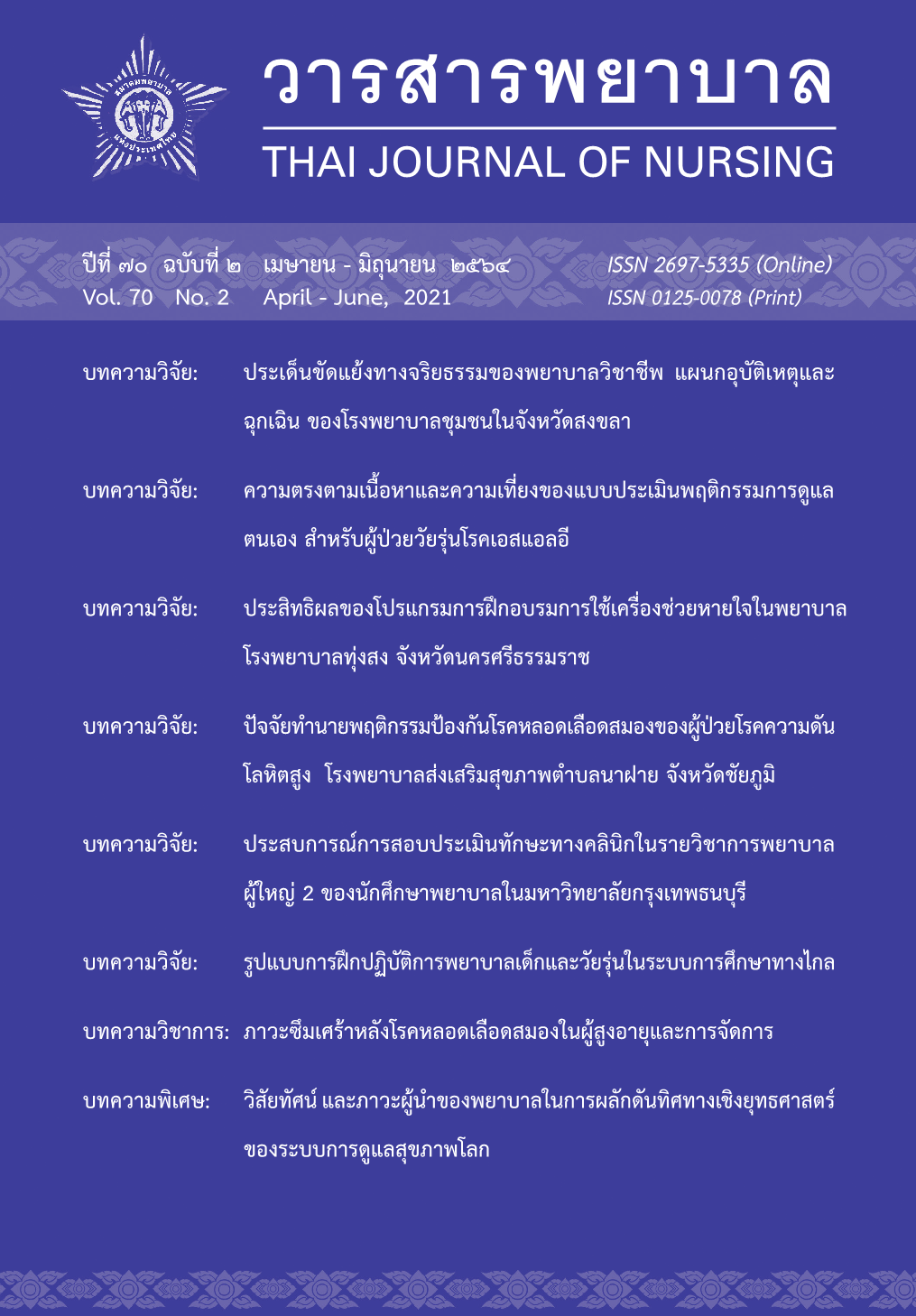Post-stroke depression among older adult and management
Main Article Content
Abstract
Post-stroke depression is common among older adult patients and has affected them on physical, mental, social and economic conditions. Thus, medical personnel and caregivers of these older adult patients should have comprehensive understanding of the post-stroke depressive symptoms including assessment and management in order to alleviate the depressive condition with respect to patients’ value.
Article Details
References
ชาฤทธิ์ วรวิชญพงศ์, และจิราพร เกศพิชญวัฒนา. (2557). ผลของโปรแกรมการเสริมสร้างพลังอำนาจแบบ
ครอบครัวมีส่วนร่วมต่อภาวะซึมเศร้าของผู้สูงอายุโรคหลอดเลือดสมอง. วารสารพยาบาลตำรวจ,
(2), 16-32.
ช่อผกา สุทธิพงศ์, และศิริอร สินธุ. (2555). ปัจจัยทำนายภาวะซึมเศร้าในผู้สูงอายุภายหลังเป็นโรคหลอด
เลือดสมองในเขตชุมชนเมือง. วารสารพยาบาลศาสตร์, 30(1), 28-39.
ประเสริฐ อัสสันตชัย. (บก.). (2558). ปัญหาสุขภาพที่พบบ่อยในผู้สูงอายุและการป้องกัน(พิมพ์ครั้งที่ 5).
กรุงเทพมหานคร: ยูเนี่ยน ครีเอชั่น.
แพรศิริ อยู่สุข, และจิราพร เกศพิชญวัฒนา. (2559). ผลของการบำบัดทางการพยาบาลโดยใช้กิจกรรมดนตรี
ต่อภาวะซึมเศร้าของผู้สูงอายุโรคหลอดเลือดสมองชนิดขาดเลือด. วารสารวิทยาลัยพยาบาล
พระปกเกล้า จันทบุรี, 27(1), 17-27.
วีระชัย จิตภักดี, สมรักษ์ สันติเบ็ญจกุล, และกฤษณา พิรเวช. (2560). ความชุกของอาการวิตกกังวลและ
อาการซึมเศร้าในผู้ป่วยโรคหลอดเลือดสมองที่ได้รับการเยี่ยมบ้านและผลต่อการฟื้นตัวของระบบ
สั่งงานกล้ามเนื้อและความสามารถในการทำกิจวัตรประจำวัน. จุฬาลงกรณ์เวชสาร, 61(2), 233-247.
วิชชุดา พุ่มจันทร์, ชนกพร จิตปัญยา, และศิริพันธ์ สาสัตย์. (2557). ปัจจัยคัดสรรที่สัมพันธ์กับภาวะซึมเศร้า
ของผู้ป่วยภายหลังเกิดโรคหลอดเลือดสมองเฉียบพลัน. วารสารพยาบาลตำรวจ, 6(2), 33-43.
สายฝน เอกวรางกูร. (2554). รู้จัก เข้าใจ ดูแล ภาวะซึมเศร้า (พิมพ์ครั้งที่ 2). กรุงเทพมหานคร: สำนักพิมพ์
แห่งจุฬาลงกรณ์มหาวิทยาลัย.
เสาวนีย์ เปรมทอง, และจิราพร เกศพิชญวัฒนา. (2561). ผลของการให้การดูแลตามแนวคิดฮิวแมนนิจูดโดย
ผู้ดูแลในครอบครัวต่อภาวะซึมเศร้าของผู้สูงอายุโรคหลอดเลือดสมอง. วารสารพยาบาลทหารบก,
(ฉบับพิเศษ), 221-230.
สุพรรษา แสงพระจันทร์, จิณห์จุฑา ชัยเสนา ดาลลาส, ภรภัทร เฮงอุดมทรัพย์, และเวทิส ประทุมศรี. (2559).
การรับรู้ความหมายความมีคุณค่าในตนเองของผู้สูงอายุที่มีภาวะซึมเศร้า. วารสารพยาบาลกระทรวง
สาธารณสุข, 26(2), 76-88.
อารีย์ สงวนชื่อ, ปัณณทัต ตันธนปัญญากร, และรัตนาภรณ์ อาษา. (2562). ความชุกและปัจจัยที่มีความ
สัมพันธ์กับภาวะซึมเศร้าของผู้สูงอายุที่มีโรคเรื้อรังในอำเภอวังน้อย จังหวัดพระนครศรีอยุธยา.
วารสารมหาวิทยาลัยราชภัฏยะลา, 14(2), 227-287.
Ahn, D. H., Lee, Y. J., Jeong, J. H., Kim, Y. R., & Park, J. B. (2015). The effect of post-stroke depression
on rehabilitation outcome and the impact of caregiver type as a factor of post-stroke depression.
Annals of Rehabilitation Medicine, 39(1), 74–80.
Brown, C., Hasson, H., Thyselius, V., & Almborg, A. H. (2012). Post-stroke depression and functional
independence: A conundrum. Acta Neurologica Scandinavica, 126(1), 45–51.
Carrà, G., Johnson, S., Bebbington, P., Angermeyer, M. C., Heider, D., Brugha, T., . . . Toumi, M. (2012).
The lifetime and past-year prevalence of dual diagnosis in people with schizophrenia across Europe:
Findings from the European Schizophrenia Cohort (EuroSC). European Archives of Psychiatry and
Clinical Neuroscience, 262(7), 607–616. doi:10.1007/s00406-012-0305-z
Chakraborty, S., Basu, R., Jana, A. K., Banerjee, M., & Sanyal, D. (2016). Prevalence of post stroke
depression in male and female patients visiting a rural hospital outpatient. International Journal of
Innovative Research in Medical Sciences, 1(6), 294- 302.
Chiu, H. L., Chan, P. T., Chu, H., Hsiao, S. S., Liu, D., Lin, C. H., & Chou, K. R. (2017). Effectiveness
of light therapy in cognitively impaired persons: A metaanalysis of randomized controlled
trials. Journal of the American Geriatrics Society, 65(10), 2227–2234. doi: 10.1111/jgs.14990
de Graaf, J. A., van Mierlo, M. L., Post, M., Achterberg, W. P., Kappelle, L. J., & Visser-Meily, J. (2018).
Long-term restrictions in participation in stroke survivors under and over 70 years of age. Disability
and Rehabilitation, 40(6), 637–645.
de Man-van Ginkel, J. M., Gooskens, F., Schuurmans, M. J., Lindeman, E., Hafsteinsdottir, T. B., &
Rehabilitation Guideline Stroke Working Group. (2010). A systematic review of therapeutic
interventions for poststroke depression and the role of nurses. Journal of Clinical Nursing, 19(23-
, 3274–3290. doi: 10.1111/j.1365-2702.2010.03402.x
Dong-Heun, A., Yung-Jin, L., Ji-Hun J., Yong-Rok, K., & Jong-Bum, P. (2015). The effect of post-stroke
depression on rehabilitation outcome and the impact of caregiver type as a factor of post-stroke
depression. Annals of Rehabilitation of Medicine, 39, 74-80.
Dossa, A., Glickman, M. E., & Berlowitz, D. (2011). Association between mental health conditions and
rehospitalization, mortality, and functional outcomes in patients with stroke following inpatient
rehabilitation. BMC Health Services Research, 11, 2-10.
Esparrago Llorca, G., Castilla-Guerra, L., Fernandez Moreno, M. C., Ruiz Doblado, S., & Jimenez
Hernandez, M.D. (2015). Post-stroke depression: An update. Neurologia, 30(1), 23-31.
Gillen, G. (2016). Stroke rehabilitation: A function-based approach (4th ed.). New York: Elsevier.
Hadidi, N. N., Lindquist, R., Buckwalter, K., & Savik, K. (2015). Feasibility of a pilot study of problem –
solving therapy for stroke survivors. Rehabilitation Nursing, 40(5), 327–337. doi: 10.1002/rnj.148
Jun, E. M., Roh, Y. H., & Kim, M. J. (2013). The effect of music-movement therapy on physical and
psychological states of stroke patients. Journal of Clinical Nursing, 22(1-2), 22–31.
Kongkasuwan, R., Voraakhom, K., Pisolayabutra, P., Maneechai, P., Boonin, J., & Kuptniratsaikul, V.
(2016). Creative art therapy to enhance rehabilitation for stroke patients: A randomized controlled
trial. Clinical Rehabilitation, 30(10), 1016–1023.
Nakase, T., Tobisawa, M., Sasaki, M., & Suzuki, A. (2016). Outstanding symptoms of poststroke
depression during the acute phase of stroke. PLoS One, 11(10), e0163038. doi: 10.1371/journal.
pone.0163038
Sarfo, F. S., Jenkins, C., Singh, A., Owolabi, M., Ojagbemi, A., Adusei, N., . . . Ovbiagele, B. (2017).
Post-stroke depression in Ghana: Characteristics and correlates. Journal of the Neurological
Sciences, 379, 261–265. doi: 10.1016/j.jns.2017.06.032
Shi, Y., Yang, D., Zeng, Y., & Wu, W. (2017). Risk factors for post-stroke depression: A meta-analysis.
Frontiers in Aging Neuroscience, 9, 218. doi: 10.3389/fnagi.2017.00218
Sugawara, N., Metoki, N., Hagii, J., Saito, S., Shiroto, H., Tomita, T., . . . Yasui-Furukori, N. (2015).
Effect of depressive symptoms on the length of hospital stay among patients hospitalized for acute
stroke in Japan. Neuropsychiatric Disease and Treatment, 11, 2551–2556.
Suwanwela, N. C. (2014). Stroke epidemiology in Thailand. Journal of Stroke, 16(1), 1-7.
doi: 10.5853/jos. 2014.16.1.1
Villa, R. F., Ferrari, F., & Moretti, A. (2018). Post-stroke depression: Mechanisms and pharmacological
treatment. Pharmacology & Therapeutics, 184, 131–144.
Wang, Z., Zhu, M., Su, Z., Guan, B., Wang, A., Wang, Y., . . . Wang, C. (2017). Post-stroke depression:
Different characteristics based on follow-up stage and gender-a cohort perspective study from
Mainland China. Neurological Research, 39(11), 996–1005. doi: 10.1080/01616412.2017.1364514
Zhao, F. Y., Yue, Y. Y., Li, L., Lang, S. Y., Wang, M. W., Du, X. D,. . . Yuan, Y. G. (2018). Clinical
practice guidelines for post-stroke depression in China. Brazilian Journal of Psychiatry, 40(3),
–334.

